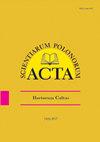The influence of chilling hours on root starch content, growth and yield of strawberry tray plants
IF 0.7
4区 农林科学
Q4 HORTICULTURE
引用次数: 0
Abstract
The chilling requirements of two strawberry cultivars (‘Sonata’, ‘Albion’) were assessed by evaluating the starch accumulation levels in the tray plants’ root system and their subsequent growth and yielding. The research was conducted in an experimental orchard and a greenhouse of the National Institute of Horticultural Research in Skierniewice, Poland, in 2017–2019 (2 cycles of obtaining planting material and growing plants). The tray plants (rooted tips) were grown in the natural field conditions until they were transferred in batches to a cold store (–2°C) on five different dates: 12 Oct., 30 Oct., 20 Nov., 11 Dec., and 3 Jan. (of the following year). The number of accumulated chilling hours less than 7°C was recorded for each transfer date, and the roots were analysed for starch content at the time of transfer. After the end of cold storage (3 months, standardised for all treatments), the plants were planted in pots and transferred to a greenhouse to assess growth and plant yielding. The obtained results indicate that chilling induces changes in the extent of starch accumulation. The highest starch accumulation in ‘Sonata’ roots was recorded when the plants received about 500 h of chilling (under Polish conditions accumulated in November/December). In the ‘Albion’ strawberry case, the maximum was found at the lower chilling level – about 300 h (middle of November). The highest fruit yields were produced by ‘Sonata’ plants, for which the number of chilling hours (0–7°C) was 500–800 h. In the case of ‘Albion’, the values were 2–3 times lower. A more extended period of keeping tray plants in field conditions (over 1000 h of chilling) resulted in a deterioration in fruit yield.冷藏时间对草莓托盘植株根系淀粉含量、生长及产量的影响
通过评估托盘植物根系中的淀粉积累水平及其随后的生长和产量,评估了两个草莓品种(“Sonata”和“Albion”)的冷藏需求。这项研究于2017年至2019年在波兰斯基尔涅维奇国家园艺研究所的一个实验果园和一个温室中进行(两个周期的获取种植材料和种植植物)。托盘植物(根尖)在自然田间条件下生长,直到它们在五个不同的日期分批转移到冷藏库(-2°C):10月12日、10月30日、11月20日、12月11日和(次年)1月3日。记录每个转移日期小于7°C的累积冷冻小时数,并分析转移时根的淀粉含量。冷藏结束后(3个月,所有处理标准化),将植物种植在花盆中,并转移到温室中,以评估生长和植物产量。研究结果表明,低温可引起淀粉积累程度的变化。当植物接受约500小时的冷藏(在波兰条件下,11月/12月积累)时,“索纳塔”根中的淀粉积累最高。在“阿尔比恩”草莓案例中,最大值出现在较低的冷藏水平——约300小时(11月中旬)。果实产量最高的是“索纳塔”植物,其冷藏小时数(0–7°C)为500–800小时。在“阿尔比恩”的情况下,该值低2–3倍。将托盘植物在田间条件下保存更长时间(超过1000小时的冷藏)会导致果实产量下降。
本文章由计算机程序翻译,如有差异,请以英文原文为准。
求助全文
约1分钟内获得全文
求助全文
来源期刊
CiteScore
1.30
自引率
14.30%
发文量
61
审稿时长
4-8 weeks
期刊介绍:
In Acta Scientiarum Polonorum Hortorum Cultus we publish original research papers and review articles containing new and significant information on broad aspects of horticulture and related disciplines. The papers are published in English only, in six issues yearly.

 求助内容:
求助内容: 应助结果提醒方式:
应助结果提醒方式:


